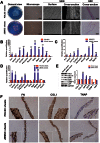The use of platelet-rich fibrin combined with periodontal ligament and jaw bone mesenchymal stem cell sheets for periodontal tissue engineering
- PMID: 27324079
- PMCID: PMC4914939
- DOI: 10.1038/srep28126
The use of platelet-rich fibrin combined with periodontal ligament and jaw bone mesenchymal stem cell sheets for periodontal tissue engineering
Abstract
Periodontal regeneration involves the restoration of at least three unique tissues: cementum, periodontal ligament tissue (PDL) and alveolar bone tissue. Here, we first isolated human PDL stem cells (PDLSCs) and jaw bone mesenchymal stem cells (JBMSCs). These cells were then induced to form cell sheets using an ascorbic acid-rich approach, and the cell sheet properties, including morphology, thickness and gene expression profile, were compared. Platelet-rich fibrin (PRF) derived from human venous blood was then fabricated into bioabsorbable fibrin scaffolds containing various growth factors. Finally, the in vivo potential of a cell-material construct based on PDLSC sheets, PRF scaffolds and JBMSC sheets to form periodontal tissue was assessed in a nude mouse model. In this model, PDLSC sheet/PRF/JBMSC sheet composites were placed in a simulated periodontal space comprising human treated dentin matrix (TDM) and hydroxyapatite (HA)/tricalcium phosphate (TCP) frameworks. Eight weeks after implantation, the PDLSC sheets tended to develop into PDL-like tissues, while the JBMSC sheets tended to produce predominantly bone-like tissues. In addition, the PDLSC sheet/PRF/JBMSC sheet composites generated periodontal tissue-like structures containing PDL- and bone-like tissues. Further improvements in this cell transplantation design may have the potential to provide an effective approach for future periodontal tissue regeneration.
Conflict of interest statement
The authors declare no competing financial interests.
Figures





References
-
- Albandar J. M. Aggressive and Acute Periodontal Diseases. Periodontol. 65, 7–12 (2014). - PubMed
-
- Manjunath B. C., Praveen K., Chandrashekar B. R., Rani R. M. & Bhalla A. Periodontal infections: a risk factor for various systemic diseases. Natl. Med. J. India. 24, 214–219 (2011). - PubMed
-
- Chen F. M. et al.. A review on endogenous regenerative technology in periodontal regenerative medicine. Biomaterial 31, 7892–7927 (2010). - PubMed
-
- Bosshardt D. D. & Sculean A. Does periodontal tissue regeneration really work? Periodontol. 51, 208–219 (2009). - PubMed
Publication types
MeSH terms
Substances
LinkOut - more resources
Full Text Sources
Other Literature Sources

